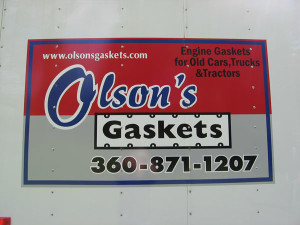Yes! We usually have one or two people hand cutting gaskets Monday through Friday. We keep a stock of felt, paper, cork rubber, neoprene, and high temp composition material on hand. We can hand cut felt, cork, neoprene gaskets and seals (We do NOT have the capability of reproducing any stamped metal seals). We can also hand cut head and manifold gaskets from our high temperature composition material. We can also do steel rule die cutting for high volume gasketing needs.
We keep a large inventory of patterns on hand. As a result we can supply gaskets for many obsolete engines from 1900-1960. This is our specialty. If we don’t have a pattern on hand we can make it based on a customer’s pattern. The best pattern is the old gasket that came off the engine. In the event that the old gasket is not salvageable then we can make gaskets based on a tracing (on a heavy paper) or tap* pattern.
* a tap pattern can be made by placing a heavy paper over the part and tapping lightly around the edges with a ball pein hammer. This will result in a tracing of the gasket. When doing this it’s important to take care not to tap so hard as to break the part or damage the sealing surface.
This is a hotly debated topic among engine re-builders of antique machinery. Generally we recommend to put gaskets on dry without any sealer. If both surfaces are machined steel and clean then gasket sealer should not be necessary. In cases where one surface is stamped tin and one surface is machined (e.g. valves covers) then we do suggest to use gasket sealer on the stamped tin side because stamped tin can warp due to over tightening or rough treatment. We always recommend to clean surfaces throughly.
Generally we have one or two gasket cutters working here in the shop. So orders are usually ready to ship within one or two days from when the order is placed.
In all honesty probably doesn’t matter a whole lot, but the old timers would often install a head gasket with the rolled edge up (i.e. facing the head and away from the combustion chamber).
Generally speaking a blown head gasket is an indicator of a greater problem. Head gaskets can blow for a number of reasons:
- Surfaces are not clean. The block and/or head has pitting and needs to be milled.
- Old head bolts or studs were not replaced and are stretching with each torque.
- Over heating of the engine due to poor water flow.
- The head was improperly torqued during restoration.

